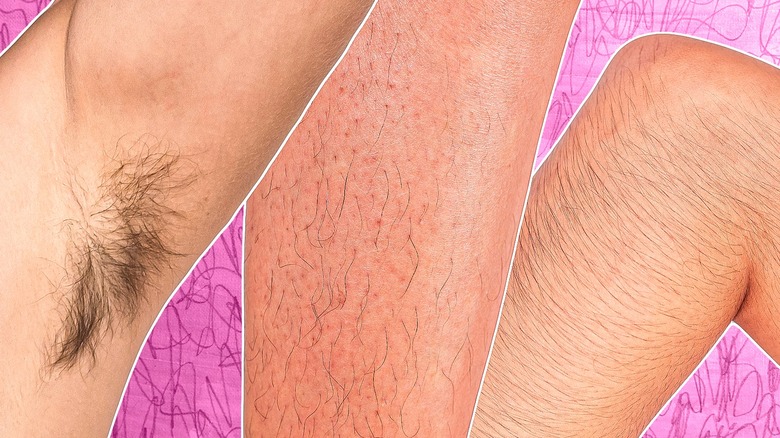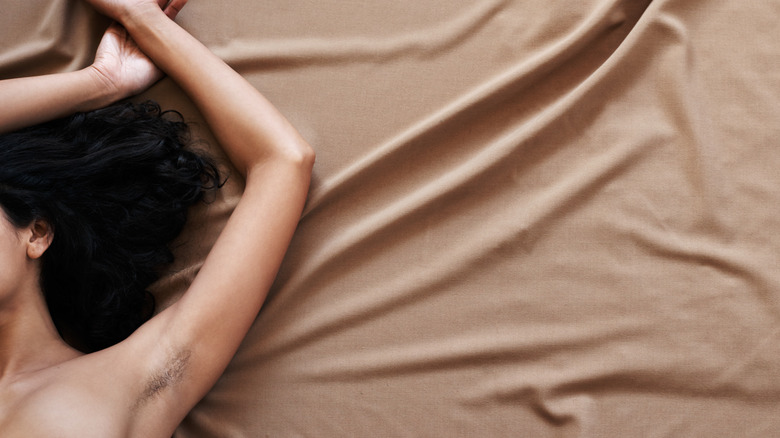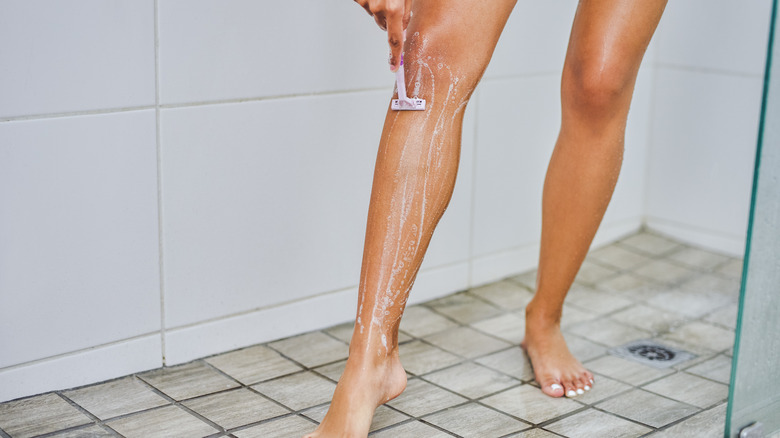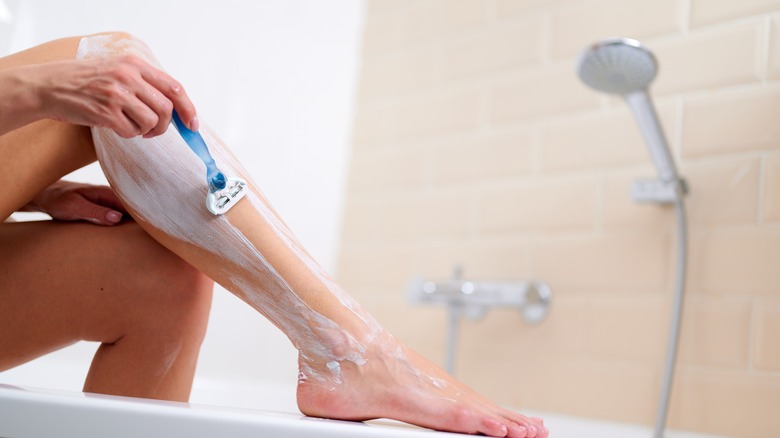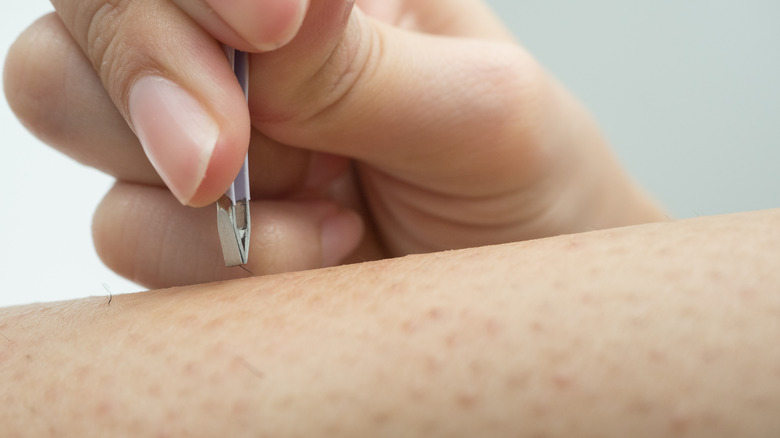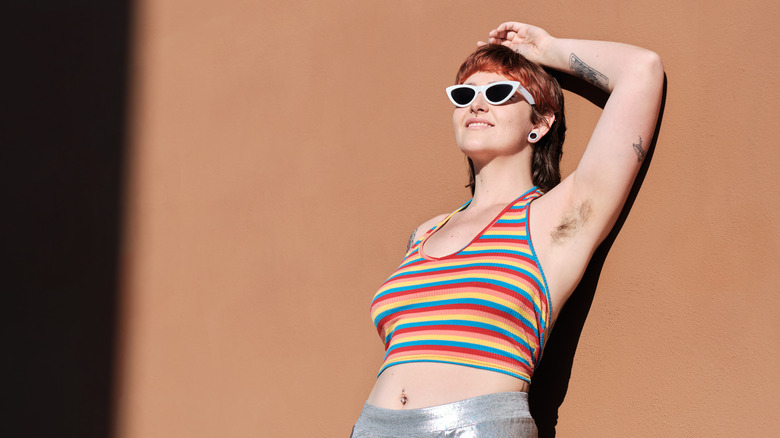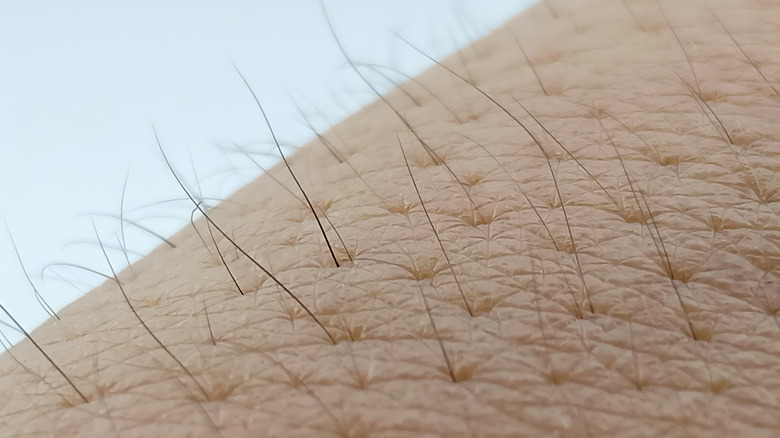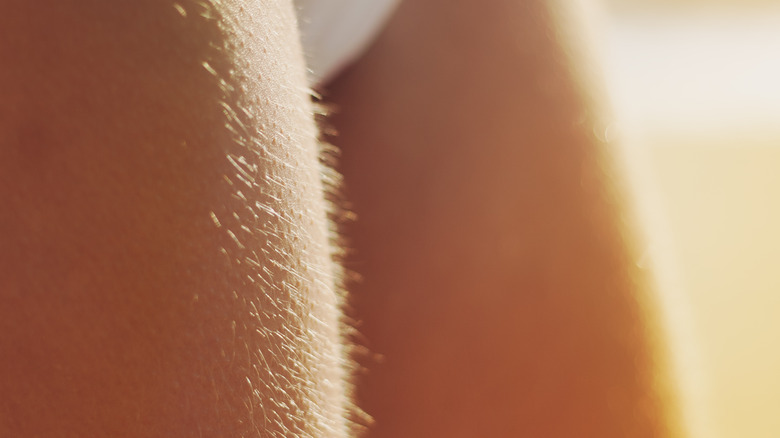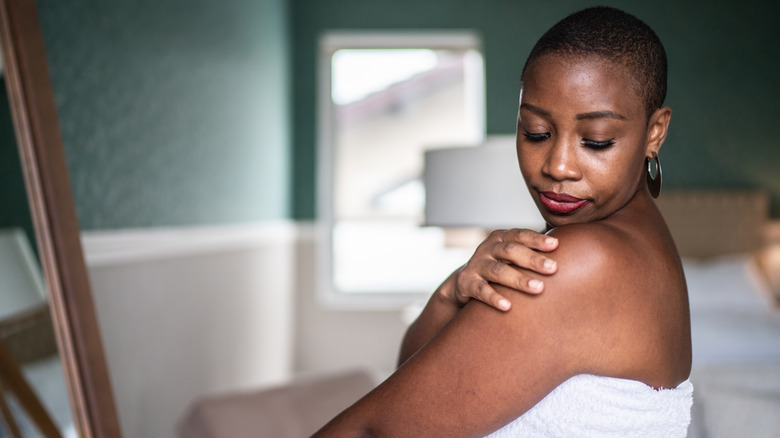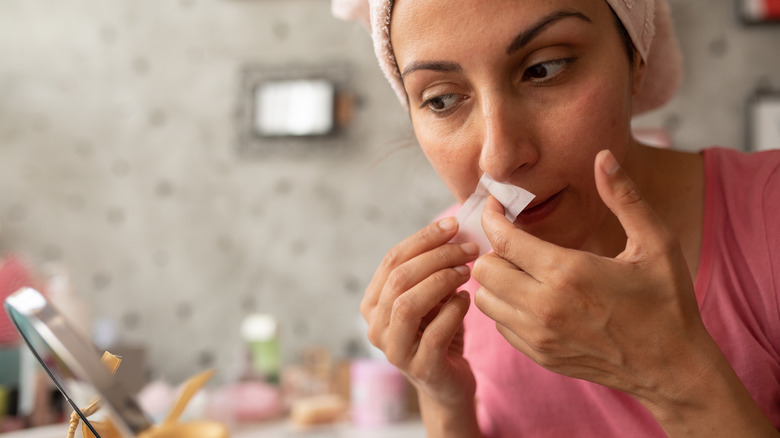Female Body Hair Facts Everyone Should Know
We grow all kinds of hair on almost every part of our bodies, but what exactly is the significance of hair in humans? We certainly grow less hair than furry primates. Plus, if anyone decides to up and shave off every strand of hair they have, there won't be a drastic effect.
A 2011 study in the International Journal of Trichology revealed that thick animal furs serve obvious functions like temperature control, camouflage, protection of the skin, mating, and communication with other animals, but the importance of hair on humans is not as obvious. Hair might not be very necessary for our survival, but there's no doubt that human hair gets a lot of attention — and that applies to more than just the hair on our heads.
Puberty kicks off the sudden growth of thicker body hair, armpit hair, and pubic hair. It's also around this time that many women begin to fuss about what to do with it. And there's no scarcity of grooming options for body hair, from shaving to growing and even dyeing it. Whatever you choose to do with it, there are certain things about female body hair you may not know. From the earliest forms of hair removal to the truth behind modern body hair myths, these facts shed a little light on this much debated part of the body.
You have different types of body hair and they each have their use
Apart from your palms and soles, you have hair all over your body. However, you might not notice most of your body hair because it's light and short. These types of hairs are known as vellus hairs or, more commonly, peach fuzz. The more noticeable body hairs — eyebrow, eyelash, armpit, and pubic hairs — are known as terminal hairs, which also make up hair on the head, as well as the facial and chest hair of men (via the Institute for Quality and Efficiency in Health Care).
All body hair has a function. Your eyebrows and eyelashes trap dust, dirt, and sweat, keeping the debris out of your eyes. Your ear and nose hair serve similar functions. The hairs all over your body trap warm air when it's cold. And the hair on your head protects your scalp from UV rays.
Hair growth occurs in three phases: the growth (anagen) phase, the transitional (catagen) phase, and the resting (telogen) phase. If you've ever wondered why your eyebrows aren't as long as the hair on your head, the reason behind that is simple: How fast and how long your hair grows depends on the type of hair and its location. The hair on your head grows fastest — and the longest — because it spends so much time in the growth phase. On the other hand, body hair grows more slowly because it spends less time in the growth phase.
Women and razors: When did it all start?
Women have had a history of going through sometimes painful lengths for hair removal to meet beauty standards, whether for religious reasons or just as a societal norm. They were even using razors in ancient Rome, primitive versions often being made from flint.
In the U.S., according to Owlcation, the first razors manufactured for shaving were made in the 19th century, and by 1903, the first razors with disposable blades were made by Gillette. Before safety razors became a thing, women only removed facial and neck hair using depilatory creams, as the fashion of the time had most of their body covered with clothing, so there was no need for shaving.
The first women's safety razors, the Milady Decolletée by Gillette Safety Razor Company, were made in 1915 during World War I. But these razors weren't so popular as shaving was still regarded as a practice mostly reserved for men. However, by World War II, more women had adopted shaving their legs with razors. The stockings that usually hid their legs were in short supply because nylon and silk were being used by the military. Hence, shaving became necessary as women's bare legs made their debut into society.
There are different reasons why women shave down there
Whether it's tamed by trimming, decorated with cute styles, shaved bald, or vaporized using laser hair removal, every woman has reasons for grooming down there.
A 2022 study published in the Australian and New Zealand Journal of Obstetrics Gynaecology highlights some of these reasons. They include the more common ones, like keeping the area neat, clean, and comfortable as part of routine hygiene. Grooming is also done in preparation for sex as women reported grooming to make the region more attractive or sexually appealing, to improve confidence, to get better oral sex, or because their partner preferred it. They also found that many women groomed for religious reasons and before exposing the area to healthcare professionals.
The study also highlights the influence of mainstream porn on women's choice to shave their pubic region. Women's genitals are often portrayed as hairless and are often retouched to give off a smooth hairless look. So mainstream porn sends out the message that being hairless down there is acceptable, expected, and sexually appealing.
Hair growing faster, darker, or thicker after shaving is a myth
It's one of the common arguments against shaving body hair that you've probably heard: "Shaving will only make your hair look worse when it grows back.” The idea that shaving stimulates fast regrowth of new hair has been disproven for some time. According to Cleveland Clinic, when you shave, you're merely removing the hair on the surface of the skin which is inactive or dead. This shouldn't affect the growing hair root within the skin.
Hair may appear thicker or darker after shaving. But those new hairs actually aren't dark, thick mutants. Older hairs usually lie down on the skin while newer hairs have a blunt tip. So this might give you the impression that the newer hairs are thicker. Additionally, your body hair is usually lightened by the sun or chemicals in skin products. So when fresh hairs grow after shaving, they appear darker than older hairs (via a 2007 study published in BMJ Clinical Research).
Ingrown hairs can be prevented
Getting ingrown hairs or razor bumps is one painful complication of hair removal. Ingrown hairs are new hairs that grow into the skin instead of outwards. As a result of this, the affected region swells, reddens, and becomes itchy. Ingrown hairs can form cysts or even get infected (via Health Direct). You can develop ingrown hairs wherever you remove hair, such as your leg, armpit, or pubic area. The tendency to have ingrown hairs is high if your hair is curly or coarse.
Ingrown hairs happen when the cut hair is forced back into the follicle or when the new hair can't grow out due to clogged pores. That's why it's important to exfoliate when you shave and cleanse the area. Another way to avoid ingrown hairs is to shave in the direction of hair growth.
Unfortunately, this last point can be tricky to follow as body hair grows in different directions (via Get Bevel). But a good way to find the direction of hair growth is to simply look at your hair. You can also run your finger through your hair. If you smooth it down, that's the direction of hair growth and if you raise it up, that's the opposite direction.
More women are embracing body hair
It's no big secret that beauty standards promote women having little to no body hair. As outlined in a 2021 paper by Brandeis University, a lot of this pressure comes from media portraying body hair as unattractive on women. Advertising and pornography play big roles by equating femininity and sexiness with being hairless. Many women are also influenced by what the majority of men think female body hair should look like: non-existent.
However, tons of women just don't see shaving as worth the effort, particularly amongst Gen Z women who have started a TikTok trend surrounding normalizing female body hair (via News.com.au). Not only are more women embracing their body hairs; they are flaunting them.
Influencers and celebrities have also played roles in normalizing female body hair. One notable name is photographer Ashley Armitage. She takes and posts pictures of women showing off all kinds of body hair. Speaking with USA Today, she admits that she got a lot of backlash when she started giving female body hair publicity in her pictures, but she's also seen a lot of positive remarks about her work. "Now I see body hair on Instagram pretty regularly," Armitage says. Many female celebrities also show off body hair, including Bekah Martinez, Amandla Stenberg, and Paris Jackson, who seek to normalize body hair.
Keeping your bush is not a crime
One big misconception about pubic hairs is that having them is unhygienic. They may give off a strong odor because they trap oil, sweat, and bacteria, but every other body hair does the same. Since the pubic hairs are more concealed and not exposed to air, you should take care of them by washing them regularly. It's important to keep the bush dry, and always wipe from front to back to avoid contaminating the hairs. You should also resist the urge to use scented products in your genital area.
Your pubic hairs have their use. They protect the delicate skin in the pubic region and reduce skin-on-skin friction during sex (via Healthline). Pubic hairs keep your genitals warm, and this warmth may help with sexual arousal. As mentioned, they trap harmful substances, keeping them away from your vagina and urinary tract. Thus, they help prevent infections. There's also a theory that pubic hairs trap pheromones which are thought to be released from pubic sweat glands. These pheromones are volatile chemicals and they could serve as sexual attractants.
You are born with all your hair follicles
Hair follicles are structures deep within the skin that form hairs. Even though hair on different body parts appears after puberty, all hair follicles are made in the womb as the skin develops. According to a 2008 study published in Current Biology, these follicles produce body hair repeatedly throughout life after birth.
This explains why hair is denser in some places and scanty in others. The amount of hair follicles on any part of your body determines your hair density. Hair on your head is dense compared to the rest of your body. This is because after birth, your head doesn't grow as much compared to parts like the arms and legs. And as a body part grows, the hair follicles on the skin move apart. Another implication of hair follicles developing before birth is that in adulthood, body areas where you have dense or thin hair will likely remain that way, as you can't alter the amount of hair follicles you have on your head or anywhere else, per Healthline.
Body hairs help you sense touch
There are different kinds of sensations you can feel on your skin, such as vibration, pressure, touch, or temperature. According to a 2013 review published in Physiology, the hairs on your skin are "innervated by one or more of three types of mechanoreceptor ending" which transfers information about "skin touch" back to the brain. In simple terms, body hair is responsible for helping you to sense and interpret physical touch, from light movement to more noticeable, pleasant sensations.
A 2017 study published in Scientific Reports reveals that the hair follicles themselves are "surrounded and innervated by a large network of sensory afferents" and are therefore "important for the sense of touch." So these skin receptors can still be stimulated even after hair removal, as methods like shaving don't affect the follicle itself. Notably, the 2017 study found that hair removal did not affect sensory reception in the study group which aimed to test the relationship between hair follicle density and touch perception.
You'll likely produce less body hair when you're older
Your body hair won't hang around forever. It's common for the body hair in the pubic region, arms, and chest to become thinner, more sparse, and gray as a person ages, per Healthline. The eyebrows are also affected, as GoodRx explains. The outer portion tends to thin out with age. When it comes to facial hairs, the opposite occurs. Many women start developing mustaches and chin hair in old age.
It can feel strange to lose hair on most parts of the body and grow new hair on the face. The cause of these hair changes has been tied to menopause. According to Cleveland Clinic, these changes to women's hair after menopause may be due to changes in hormone levels. These hormonal changes are also responsible for the loss of hair on the head that some postmenopausal women experience. This type of hair loss has been termed female pattern baldness.
Unusual hair growth or hair loss might be a sign of a health condition
Hair growth is different for each person. Some people naturally have less or more hair than others. But if you notice that your body hair growth has increased or decreased unusually, there might be an underlying cause.
For example, growing a lot of thick, terminal hair in a male pattern (on chest or face) might be a sign of hirsutism, which can come down to the overproduction of androgens. This could be due to a number of conditions, the most common being polycystic ovarian syndrome (via the American Academy of Family Physicians).
Unusual hair loss can also be linked with nutrient deficiencies. There are many nutrients involved in the normal growth of hair, so any deficiency can affect the structure, texture, and growth of hair. Some of these nutrients include iron, zinc, vitamin D, biotin, per Healthline. Also, sudden weight loss can impact hair growth if it is the result of malnutrition. If you notice unusual hair loss or growth it is important to see your health care provider to find out if there's a medical cause, and to find the best treatments.
